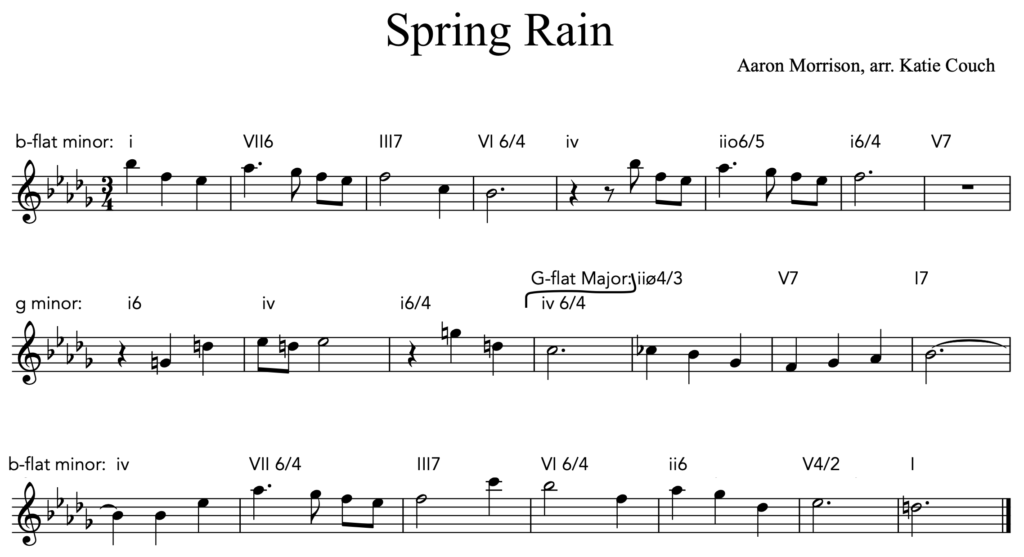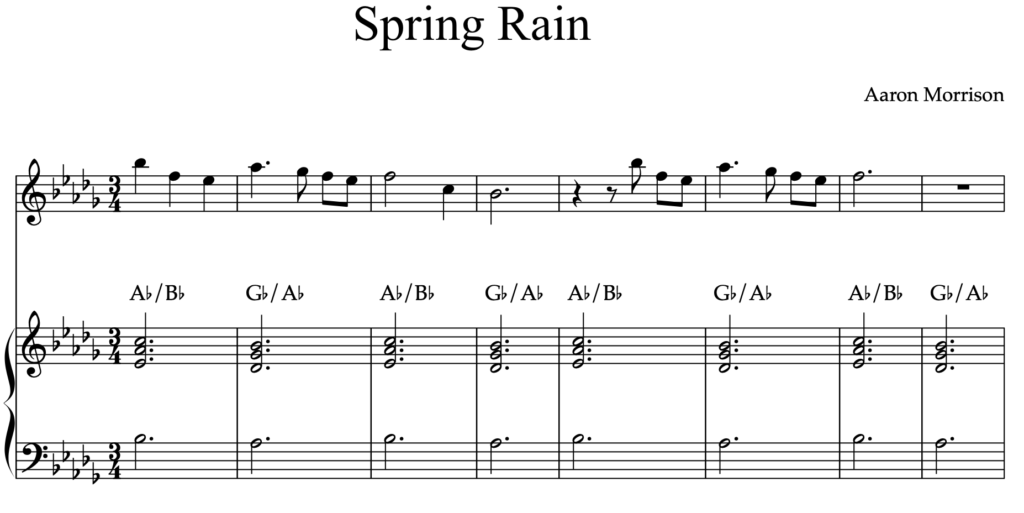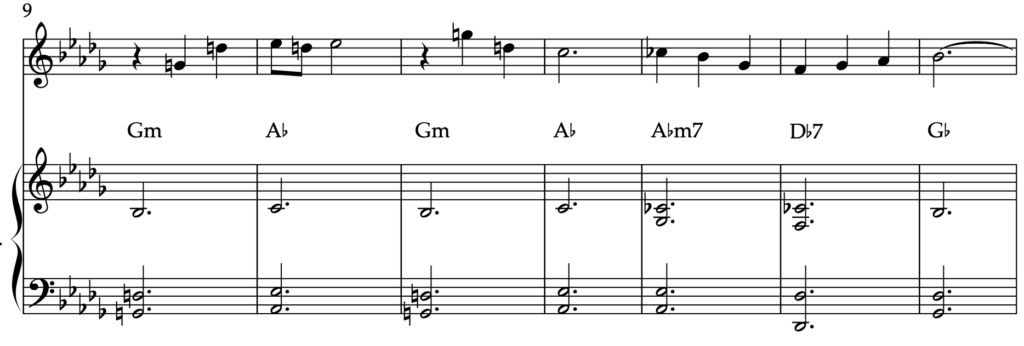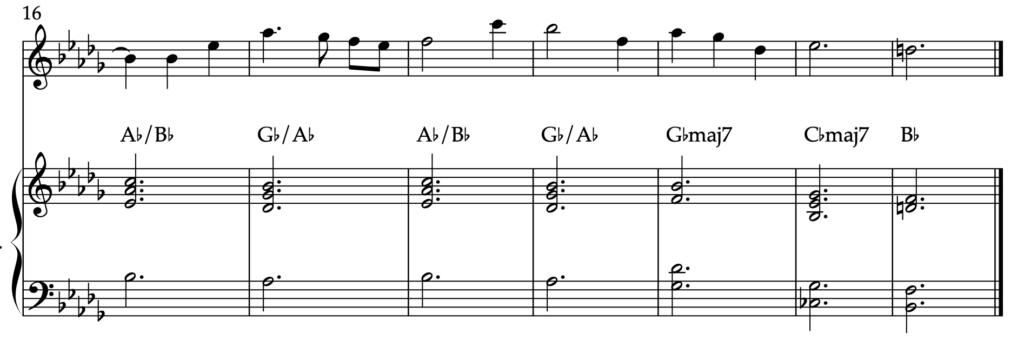
Improv Exchange: Aaron Morrison
Welcome to the Improv Exchange, a new regular feature in Dalcroze Connections, the official magazine of the DSA. In this column, you’ll find inspiration to help kick-start your own improvisations at home or in class.
The upcoming issue of Dalcroze Connections (vol. 7, no. 2; to be released digitally on May 9, 2023 and in print shortly thereafter) features the work of Aaron Morrison: a composer, multi-instrumentalist, and passionate music enthusiast. In addition to the magazine column being pre-released here on the blog, we are also including some bonus content to help you in your improv inspiration, so don’t forget to scroll all the way down!

“Spring Rain” and an Improv Idea

Like the play of light on an early spring morning, “Spring Rain” has a bright but wistful feeling. The harmonic backdrop moves between perfect fourths and major thirds, passages of diatonic harmony in G-flat Major, and relationships of thirds as the sunlight breaks through into the lovely B-flat Major at the end.
For your own improv: start by using the indicated chord tones to create a melody (taking the lead of the actual melody), especially as the harmony planes up and down. Enjoy the release into the G-flat Major tonality at bar 13 when it finally lands on the ii7-V7 (A-flat mm7 to D-flat Mm7), and indulge yourself in the lovely major third of the final chord before the clouds dim again.
Analysis and improv idea by Michael Joviala
Bonus Content!
In this special magazine-preview version of Improv Exchange, we are sharing some improv takes on ‘Spring Rain’, as well as the composer’s own chord realization and our interview with him.
Interpretations of ‘Spring Rain’
Some of the DSA’s own Publications Committee has recorded their own improvisation ideas that arose from playing through the lead sheet to ‘Spring Rain;’ here are a few of those recordings, followed by the thoughts that went into them.
Besides my work with the DSA and teaching undergraduate courses at Carnegie Mellon, I spend many of my afternoons playing piano for ballet classes in the CMU School of Drama.
Because (in my not-so-humble opinion) a lot of music composed for ballet leaves much to be desired, I find myself improvising most of what I play. I’m constantly looking for music to inspire me, music to generate new ideas for class. Why not use Aaron’s tune for a rond de jambe combination?
In order to make this tune work in class, I was forced to change the phrase length and add a repeat to make it “square”—that is, a multiple of 16, 32, or 64 beats appropriate for the exercise provided by the teacher. Can you tell where I made the edit? I also added a four-bar introduction.
Here’s what I came up with, recorded during class earlier this year. (In the background, you can hear the teacher calling out some reminders for these beginning students!)
Alex Marthaler

Reharmonizing this piece using “classical” harmonies took me quite a bit of work. I was oftentimes reminded of the improv classes I took with Laurent Sourisse at l’Institut Jaques-Dalcroze, which consisted heavily of diatonically harmonizing a modulating melody while employing chromaticism. Drawing on those lessons, I aimed here to use a stepwise bass line, which sometimes ascends and other times descends. Alas, I was not able to make any use of chromaticism, but I did use the major VII chord a few times, which is rare (for me). I found it very challenging to modulate from b-flat minor to g minor and perhaps I need to call up Laurent for a solution! After finishing my harmonization, I then read through the composer’s own chord progression and was pleasantly surprised to see a modal harmonization of the melody. My chord progression is below:
Katie Couch

Interview with Aaron Morrison

Alex Marthaler recently sat down with the composer to learn more about how he put this piece together.
What was your process in composing this piece? Was it different from your typical process?
This piece was a microcosm of my typical process. Usually I come up with a concept, but in this case, there wasn’t a concept. What’s the mood, what’s the style, what’s it about? But that wasn’t the case here.
This piece started with just those two piano chords that go back and forth, under a melody. I usually start harmonically and then come up with a melody on top of that. I started singing over it and just singing words, phrases, looking through books to find combinations of syllables and words that could fit into a melody.
There are a couple different versions of words to it. I didn’t like any of them, so I just kept it with a melody.
How did you choose the key? I’m curious.
It’s where my fingers like to go. I like flat keys a lot. I think generally when I improvise, it ends up in A-flat or E-flat. Somewhere in there.
CMU students take four semesters of eurhythmics and you’ve also participated in some summer workshops. Do you think that work has influenced your composing? How?
I sing a lot more when I compose, I try to embody it more. Having a physical connection to music has made my process different.
When I first started, I was more in my head about chord progressions, structure and form, and how it would all fit together. But now, I think a lot more about phrasing and how a certain gesture will transform to a different gesture naturally and organically. How would someone perform it?
I start a lot of pieces from improv, singing or playing at the piano. I’m always playing, humming. Sometimes I like to walk around the room.
Do you have any tips for how this piece might be expanded by a reader?
I don’t want to guide people to do any specific thing, because that’s the whole joy of improvisation. I’ll share some starting points for how this melody could be more interesting.
There are an uneven number of bars when the B section returns to the A section unexpectedly. Try feeling the B section as truly that many bars—the end of one phrase as the beginning of another. What else could you do with that transition? Where else could it go?
You might also try to have a contrasting character between the two sections, which are registrally different. You might move your body in a certain way when it’s higher up, then differently when it moves to the lower register.
You could also try to think of it in 6/8 if you wanted to. I didn’t try that, but it would be a challenge.



Read the full article and more, coming in the Spring 2023 issue of Dalcroze Connections, Vol. 7 No. 2.